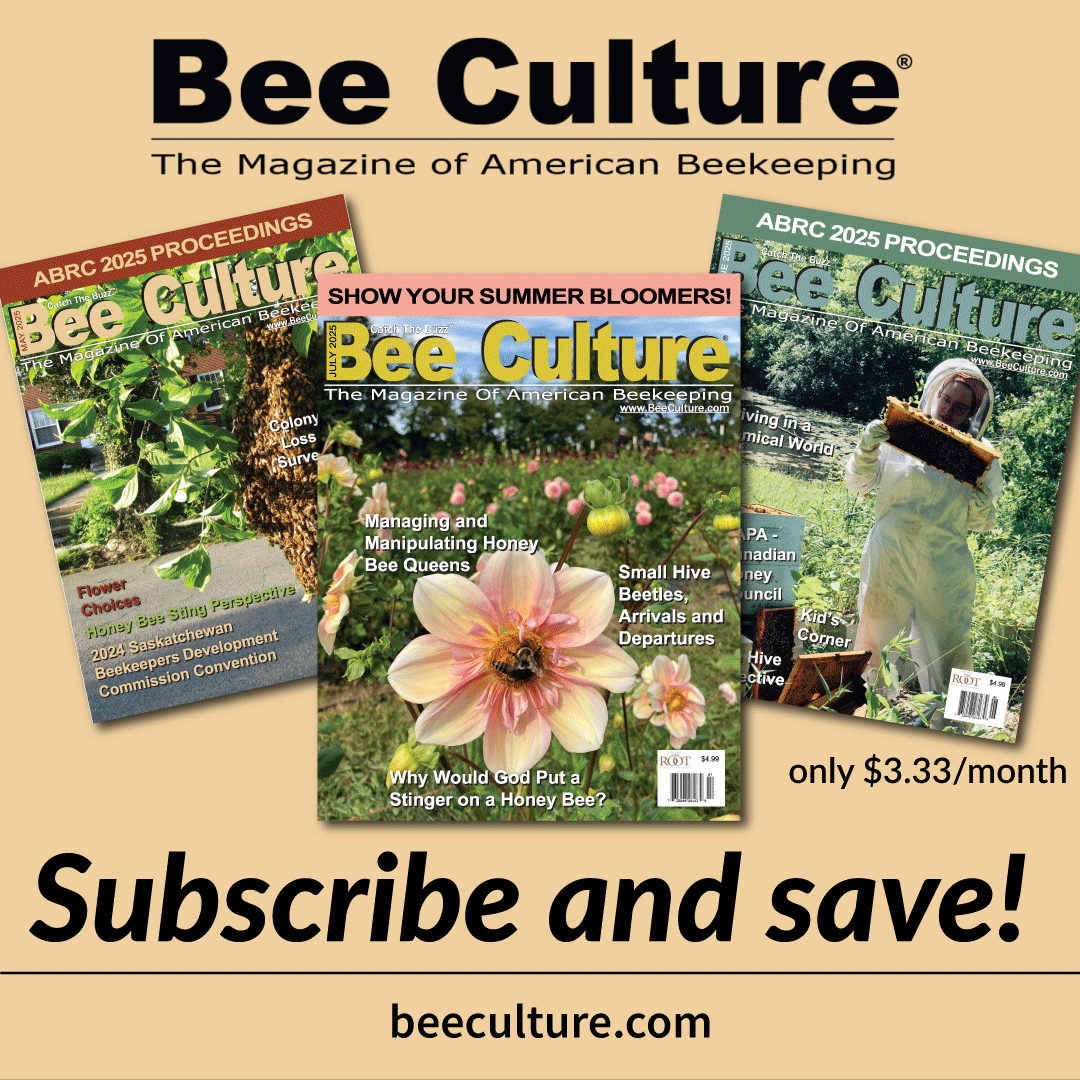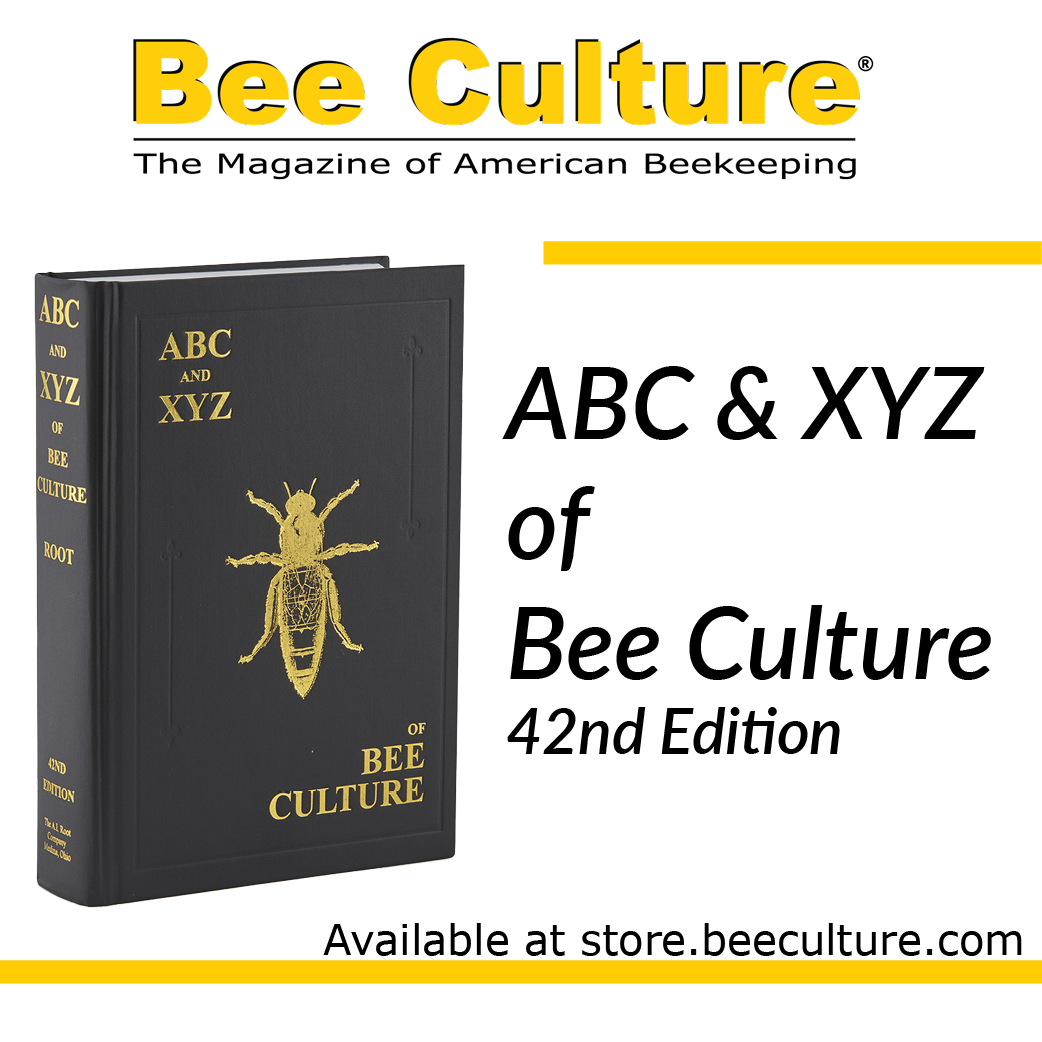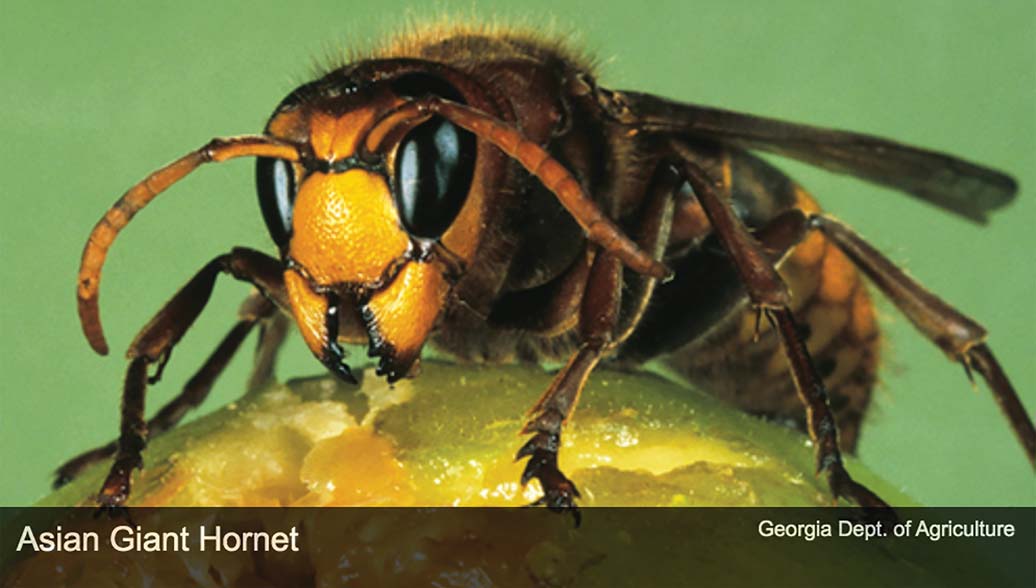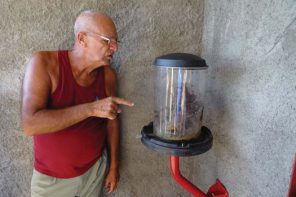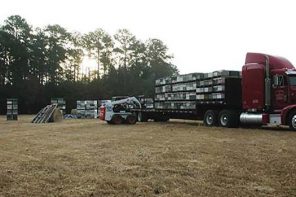By: Jennifer Berry
The first time I saw the video of Asian giant hornets devouring a honey bee colony, I was heartbroken. To watch those innocent workers flying out to protect their family, only to be slaughtered at their front steps, was very disturbing. Not to play it lightly, but it reminded me of a scene out of Game of Thrones, where our hero’s family had no chance of survival, no matter how hard they fought. At the time I watched the disturbing video, the hornets were still contained within the borders of Asia, but that is not the case now. Since then, the Asian giant hornet has found a way to invade our Western shores. Descending out of the sky like Rodan (fictional character from the Godzilla series), with its fiery breath and blood soaked fangs, it is here to terrorize, not just our bees, but us as well. The “Murder” hornet is on the hunt, so grab your children, run for the hills, hide in your homes, lock your doors, board up your windows since this time, self-quarantining and social distancing won’t save you from this venomous killer!
Ok, did I get your attention? Are you scared? Have I triggered an emotion? That is exactly what the journalist intended when he titled the article ‘Murder Hornets,’ with stings that can kill . . . This is what discourages me about SOME journalists when they use language to evoke fear. I guess they were tired of writing about Covid-19. Back in May, the article went viral, hence calls and emails from concerned citizens across the country started bombarding county agents, universities, and anyone else involved in agriculture or would pick up the phone. The article did exactly what the author intended it to do, panic folks about this potentially new, invasive species. Even though it is months after the New York Times expose, I wanted to write this piece with factual information for beekeepers to help calm anxiety. Together, with factual information, instead of fear conjuring words, we can help spread correct news to our friends, neighbors and the public. So, here are the facts, just the basic facts . . .
In August of 2019, three Asian giant hornets (AGH) were identified by provincial authorities in Nanaimo, British Columbia, Canada. In December 2019, the U.S. Department of Agriculture’s Animal and Plant Health Inspection Service (APHIS) confirmed the identification of an AGH specimen collected by a landowner in Blaine, Washington.
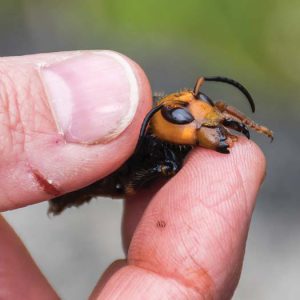
Dr. Looney, entomologist for the Washington Department of Agriculture
holding an Asian giant hornet. WA Dept of Ag photo
Last year there were several other unconfirmed sightings in the Pacific Northwest along with a nest being destroyed in Nanaimo, British Columbia. There was also a report of a colony being killed, but this has not been confirmed as a result of an AGH attack. To date, when this article was written, confirmation of the AGH in the United States has only been in Washington state.
Since the release of the “Murder” Hornet article, our lab and the University of Georgia’s Entomology Department have been fielding numerous phone calls and emails. One question that everyone wants to know, (other than is it in Georgia (NO!), is, how did it get here? Well, unfortunately, at this point, no one really knows. There are several theories on possible pathways, but these are just speculations. In Asia, hornets, including the AGH, are used for food, as energy supplements or as performance enhancement products. Hence, it may have been brought here on purpose to farm as an industry. Last year, a package was intercepted at a US port of entry. This package contained live AGH larvae and pupae. The larvae would have more than likely perished but the pupae could have survived, thus forming a colony.
What is the more likely scenario of how the AGH got here? Like so many other invasive species, it was accidentally brought in. As you know, there is a tremendous amount of commercial traffic between Asia and the U.S. It probably was an overwintered, hibernating queen/s that were stowed away in the ballast of a ship, in plant material or hiding in a palletized container destined for the West coast. My wager goes with ‘accidentally introduced’ as with so many other things that have slipped into our country.
The Asian giant hornet, Vespa mandarinia, is a “true” hornet and the world’s largest, ranging in size from 1.5 to slightly over two inches long (38-50mm).

Dr. Looney with a hornet on his jacket. WA Dept of Ag photo.
The AGH was first described in 1852 and has many names associated with it: the Japanese hornet, yak-killer hornet, and the giant sparrow bee. Due to their advanced social organization, cooperative brood care, and overlapping generations, this defines them as eusocial. Similar to honey bees, they are haploid-diploid with females containing two sets of chromosomes and males only one.
The stinger is nearly ¼-inch long and can deliver a powerful sting. Typical beekeeping attire will not protect you from this pest due to the length of its stinger. Special “hornet suits” should be worn if you are going to encounter these beasts.
Each year in Japan, 30-50 people die from being stung by these ferocious hymenopterans. The venom is also more toxic and the AGHs can sting repeatedly, unlike honey bees, since their stingers are not barbed. Those who are allergic to bee or wasp stings should take particular caution around them and calmly leave an area if they have seen a AGH. Actually, anyone, allergic or not, should be careful in the vicinity of these hornets.
The AGHs natural range is in the temperate to tropical forested areas of Asia.
But as with a lot of invasive species, man’s movement has facilitated its spread to regions outside of these areas. And therein lies the problem. Once a species, (plant, arthropod, bird, mammal, bigfoot) escapes its natural boundaries, issues arise. Since it didn’t evolve in its new digs, there are no natural predators to keep it in check. Take Chinese privet for example. If you live in the south, and you have land, then you have probably encountered this vegetative beast. Here on our farm, our mission is clear: search and destroy. But for every 10 plants we remove, it seems 20 pop up a few yards away. Nothing wild eats it, not even deer, which chew on everything you don’t want them too. Time will tell, but I’m thinking there won’t be too many critters going after the AGHs for an afternoon snack.
AGHs annual life cycle is similar to other hornets. An overwintered, fertilized queen will emerge when temperatures begin to rise in the spring. She will feed on sap from nearby trees, to provide energy. Once strong enough, she will begin to search for suitable nesting sites. AGHs prefer to nest in the ground and will inhabit abandoned rodent burrows or cavities formed by rotting roots from trees. Unlike most hornets, the AGH does not form paper nests hanging from limbs or structures but instead forms nests in the ground in forested areas (much like yellowjackets). These nests can get pretty large as well, with hundreds of individuals. Once the queen has established a rudimentary nest, she will start her colony by producing an initial clutch of around 40 eggs. This will become the first generation of workers with developmental time of about 40 days from egg to adult. As this first generation matures, and as more workers are reared, they will eventually take over all of the foraging and rearing duties. The queen will then become nest bound with her only job to lay eggs, this is called the polyethic stage.
In the Fall, the colony enters the reproductive stage. Fertilized eggs laid by the queen will become the next season’s queens and unfertilized eggs will become males. Once the males have become mature, they will leave the nest and wait for their sisters to venture out. Up to a month later, the reproductive queens emerge and mate with the males, who have been patiently waiting at the hive entrance. Males will die off but before the chill sets in, fertilized queens will find a suitable location to overwinter. They will dig into the soil, rotting wood or vegetative matter for their Winter slumber. Here she will hibernate until Spring when the cycle will begin again. Back at the original hive, the mother queen and her workers will die. Queens live for a year, while her workers live on average 15-35 days after emergence.
AGHs are predators of many types of arthropods from beetles to praying mantis, spiders and caterpillars. They will also attack and devour entire nests of yellowjackets and paper wasp colonies. As they chew and consume their prey, they turn them into a “meat ball” which will be a yummy meal for themselves or their hungry larvae back at the nest. Being turned into a meatball is not my idea of a good time, but unfortunately most arthropods have no defense against the AGH’s massive jaws and powerful stingers. But there is always an exception to the rule.
Have you seen the National Geographic video of bees “cooking” a hornet to death? Here’s the exception. This is the same AGH, but unfortunately not the same bee found here. AGH evolved with Apis cerana, which has developed a defensive response of cooking hive intruders. The bees lure the invading hornet into the hive, and pile onto it, covering the hornet completely. They then begin to vibrate, raising their thoracic temperature to over 115 degrees which is lethal to the hornet but tolerable to bees. Unfortunately, Apis mellifera does not display this behavioral trait.
Back in May, our lab, in concert with the University of Georgia’s Center for Evasive Species and Ecosystem Health, put together some informative documents, one of which I want to share here (others you can find on our website, www.ent.uga.edu/bees).
As you can see, the AGH looks similar to our other U.S. hymenopteran residents, especially cicada killers. There are some key elements which can help to correctly identify a AGH. One, look at the orange head and black eyes of the AGH. It is enlarged almost to the point of being comical. Also, the size, they are quite large, up to two inches. These are easy to see, key factors in helping to distinguish between this and other wasps and hornets. We have already received emails from fearful homeowners proudly displaying dead beetles, wasps and cicada killers they thought were AGHs; I figured this would happen. Saddens me, since I hate to see cicada killers being slaughtered for no reason. Ok, I’m weird, but I love cicada killers, they are not aggressive and are so lovely to observe. Back to the story.
The Asian giant hornet is not necessarily aggressive towards humans, livestock or pets but will sting if provoked. However, this giant killer can inflict a devastating blow to honey bee colonies, with as few as 20 hornets annihilating 30,000 bees within a few hours. There are three phases to an Asian giant hornet attacking a honey bee colony. The first is the hunting or hawking phase where individual hornets search out a colony of bees. Once located, they will capture bees at the entrance of the hive, cut off their heads, and chew up the thorax forming a “meat ball”. They then carry this back to their nest to feed their young the protein-rich meal.
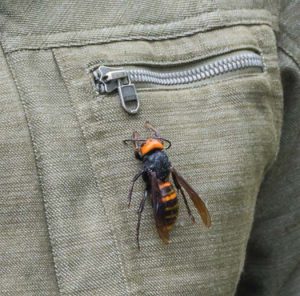
Close up of an Asian giant hornet on Dr. Looney’s jacket.
WA Dept of Ag photo.
The second phase is the slaughter phase. Single hornets will mark a particular colony with a pheromone to guide their sisters to the next target. Once assembled, numerous hornets will descend upon the colony, killing all of the workers by ripping their heads off, and dumping their bodies onto the ground below. One AGH can kill a bee every 14 seconds and they stick around for hours. When the colony is void of bees, the hornets behave as if this hive is now their own, becoming extremely aggressive to anyone or anything coming near. This is an important fact that every beekeeper needs to know. If you see a colony being attacked by AGHs or flying in and out, do not approach the hive because they may attack you. As mentioned earlier, even a bee suit is no protection from their stingers. Don’t take the risk, call your local county agent, or bee inspector; but hopefully, we will never encounter such a scene.
The third is the occupation phase. Here the hornets enter the hive, collect pupae and larvae for several days until the food is exhausted and then return to their own nest to feed their carnivorous young. The aftermath of an attack will be piles of decapitated or ripped apart bees in front of a colony.
The visible key to an Asian giant hornet attack is “decapitated” or “ripped apart” bees, and not just a pile of intact dead bees, which could be the result of pesticides, starvation or something else. Skunks, shrews or other insect eating predators sometime will dine on honey bees leaving chewed up body parts in front of the hive, but rarely do they destroy an entire colony.
In 2004, Europe saw the introduction a similar species V. velutina, which quickly spread. This is a smaller version of Vespula but has caused two deaths in France. Also, more bad news, beekeepers in areas where this hornet is present, have reported a 30% decline in colony health either by being destroyed or weakened by the hornets. This has also had a direct impact on honey production with a reduction of up to 60% in some regions.
Obviously we DON’T need this beast to become established here in the states. It’s hard enough to handle Varroa and small hive beetles, we don’t need this in the mix too! Thankfully, the Washington Department of Agriculture (WSDA) is taking this very seriously and is working diligently to try and contain this pest, but no one knows if they will be successful. According to Anne LeBrun, National Policy Manager for Honeybee and Pollinator Pest Programs in the U.S. Department of Agriculture’s Animal and Plant Health Inspection Service (APHIS), “in fiscal year 2020, APHIS has provided over $400,000 to support exotic hornet research and the WSDA delimiting survey and eradication activities are designed to prevent the Asian giant hornet from becoming established in the U.S. APHIS is drafting a Biological and Environmental Assessment to help WSDA destroy any hornet nests, if detected. APHIS is sharing information about this pest with the National Park Service, U.S. Forest Service, and Armed Forces Pest Management Board because all three agencies oversee federal lands in the area. APHIS will also provide updates to stakeholders working to support agricultural pollinators in the United States.” It’s obvious that Washington state and USDA are taking this issue extremely seriously.
This is what they are up against. AGHs are powerful fliers with an average speed of up to 30 kph (18 mph). They can also forage up to 8 kms (5 miles) in search for food. Both distance and flight ability will contribute to their dispersal. One key to eradicating the species here in the U.S. is eliminating the queens. Trapping and killing overwintered queens in early spring, before they are able to make a nest, is crucial. Or in the Fall, killing the “next seasons” queens before they dig in and hibernate for the Winter. Another strategy is to locate and destroy already existing nests, but this can be very labor intensive because locating a nest is not easy. One way is by capturing a worker in the field and then tying a streamer to her body and hopefully being able to follow her back to the nest. Thermal imaging cameras have also been used to detect nests underground, but again, is labor intensive and where do you start looking? There are also baited and attractive traps being tested and used to try and lure them in. At this time, Washington State Department of Agriculture is engaged in a number of activities to try to contain and eliminate AGHs, but it’s not going to be easy.
Beekeepers, we are on the first line of defense since AGHs seek out and destroy colonies of honey bees. A sighting, colony attack or the aftermath thereof, may be the first indication of its arrival in our area. That is why it is very important for us to familiarize ourselves with what the AGH looks like and how it compares to our local bees, wasps, or other insects. It would also be very beneficial if we can get the word out to our friends and neighbors as well. We really don’t need a bunch of folks running about trapping and killing anything and everything that is flying around but at the same time we all need to be vigilant in case it makes an appearance. Let’s hope this is the last we will hear of the Asian giant hornet, but if it does escape the borders of Washington, we, with an educated eye, will be able to correctly id it. We need to be aware, not scared, we need to be educated, not afraid, we need to be ready, not surprised!
Take care of you and your bees!
Jennifer Berry is Research Leader at the University of Georgia Honey Bee Lab.
I want to thank the following for their input – Anne Lebrun: National Policy Manager for Pest Management and Plant Health Programs, USDA APHIS; Dr. Chris Looney, Entomology Lab, Washington State Department of Agriculture; Karla Salp, Public Engagement Specialist, Washington State Department of Agriculture , University of Georgia, Center for Invasive Species and Ecosystem Health

